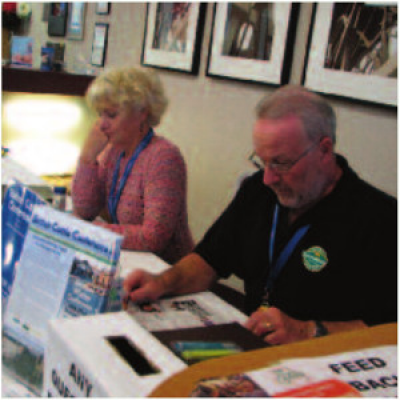A message from the new Chairman

I attended my first BCBC conference in 2005 and have been a regular ever since, apart from this year, when I was diverted to China for a meeting with the Chinese authorities on exports. The aim of the talks was to continue to explore ways in which we can increase the volume of meat exports. At present, only our pig meat is exported to the country and we are trying to develop opportunities for other meat in the future. Progress has been made and I am hopeful that this will eventually lead to the market opening for UK exporters from our beef and dairy sectors.
On a more general note; in 2006, we had no export markets for British beef at all, whereas today we are selling into more than 70 different countries across the world. There is considerable demand for high quality beef from the pasture-based systems we have in place. We can offer global consumers a safe, healthy and wholesome product that is produced to high welfare standards. The same is true of the dairy sector, which is increasingly finding overseas markets for its high quality products.
As BCBC chairman, I will be present for the duration of the 2015 British Cattle Conference and I would urge anyone with an interest in cattle to book a place. It is a very special event, with a unique blend of experts from all aspects of the industry, from producers, to scientists, academics, vets and regulators.
The question and answer sessions after each speaker presentation always turn into a lively debate and the meal breaks and evening dinners offer very good opportunities for networking. There is a great sense of camaraderie at the Cattle Conference and I consider it one of the most important events in the agricultural calendar; I hope to see you there.
Dr Phil Hadley Biography
Dr Phil Hadley originally trained as a butcher and meat inspector, before studying for an MSc in Meat Science at Bristol University and going on to gain a PhD in Animal Production at Nottingham University. After spending several years researching livestock parasites, he joined EBLEX in 2004. Phil has a particular interest in meat quality, fifth quarter products and meat hygiene.
Leigh Sullivan - Digital Dermatitis

Liverpool University student, Leigh Sullivan presented her interim findings on digital dermatitis to delegates. She stressed that the disease costs the industry many thousands of pounds each year, as well as compromising cattle welfare.
“There is no single effective treatment for digital dermatitis; it is extremely difficult to combat and we still have a lot to learn about how it is transmitted,” said Miss Leigh.
“It seems that the lesions are generally more severe in beef herds, compared with dairy herds, but that may be because dairy cows’ feet receive more regular attention.”
Part of her investigation focused on hoof trimming, to see whether bacteria on trimmer blades could be a factor in the transmission of the disease between animals.
“Samples taken from blades showed that bacteria were present on the equipment, even after disinfection, although it was not certain whether the pathogens were still active. This is an area where more work is needed, and it would also be worthwhile to see whether infection is routinely passed from cattle to sheep,” she said.
Holstein Young Breeders President’s Medal
The conference hosted the presentation of an award to Michael Lawrence, from the Lancashire Holstein Young Breeders club. He was the winner of the HYB President’s Medal, which is given to the member who has made an outstanding contribution to the breed and to their club. Michael was presented with the award by Holstein UK president, Jimmy Wilson.
A Harper Adams graduate, Michael works on the family farm with the 180-cow Lynholme herd of pedigree Holsteins. As a newcomer to the club, Michael was commended for his positive attitude. Runners up for the President’s Medal were Annabelle Doig, Norfolk HYB, and Stephanie Whittaker, Western HYB.
Conference: The speakers
Kevin Beaty - Are Consumers Influencing Farm Practice?

A dairy farmer all his life, Kevin Beaty started out milking 40 cows with his father on the family farm near Carlisle in Cumbria. He has since set up a joint venture, milking a 300-strong herd on a grass-based system.
He pointed out that while average herd size, as well as output, had increased over the past five decades, income from milk per litre had suffered a general downward trend. This was despite a background of subsidies and major technological advances. A number of factors were to blame for this situation, one of which was the rapid growth of the large retailer sector, which had encouraged consumer demands for ever cheaper food.
“Large supermarkets offer a wide range of foods, including out-of-season products. We have also seen growing interest in celebrity chefs and TV food channels and a general rise in the affluence of the population,” said Mr Beaty. “As tastes have changed, the desire for knowledge about food provenance has grown.
“Most consumers base their perceptions on information they learn from advertising and food programmes. So when they are asked if they care about how animals are farmed, they think of cows eating grass and of small farmers who care for their animals in romantic settings; this has become their view of traditional farming.”
Mr Beatty commented that this romantic image of farming was linked to the demands for farm assurance schemes to cover welfare outcomes and even stricter measures set out in some supermarket direct contracts. But it was at odds with the desire for ever cheaper food.
“We are at a crossroads, where units will grow beyond what could be classed as traditional farms. I believe this is leading to a clash in our industry, which can only be managed by educating the public about how livestock farming is changing to meet the needs of our growing population, without compromising animal welfare or the farmed environment.”
Animal welfare groups in Europe are lobbying for strict rules which are based on emotion rather than scientific fact, he said. This could result in laws which will adversely affect large, efficient UK farms and result in the growth of cheaper imports.
He advised farmers to work with their levy organisations and Government, to create useful databases for welfare outcomes and inform a debate which is in danger of being overtaken by misinformation.
“Opportunities exist for our dairy and beef industry to grow and increase exports from large-scale enterprises, which offer consumer friendly production systems. I would urge all producers to help educate our consumers and influence their behaviour, while we are developing our industry,” he concluded.
Donald Biggar - Breeding Efficient Suckler Cows

Mr Biggar runs a mixed holding near Castle Douglas in Scotland. His family has been farming for seven generations and currently supplies Marks and Spencer, Morrisons and Sainsburys with beef. The holding supports a large number of suckler cattle, including small herds of pedigree Beef Shorthorn and Aberdeen Angus.
Mr Biggar opened his presentation with the comment that British beef producers currently enjoyed the highest cattle prices in the world, as well as benefiting from the support offered by subsidies. He also observed that despite a “succession of challenges,” red meat had shown its resilience, by remaining a popular food.
“Why then are suckler cow numbers continuing to decline?” he asked. “If these benign trading conditions cannot give producers profit and confidence to continue or expand their enterprises, fundamental changes are required to our cost structures; I doubt very much whether any one organisation along the food chain is prepared to pay further price increases.
“We now have a high cost production system which relies on grain feeding not only for the finishing of the beef animal, but for the maintenance of the cow herself. Some of our competitors’ herds require no winter housing and can survive winters with little or no feed supplementation. Their fixed costs are also much lower.”
To enable the UK to compete in the global market, beef producers of the future would have to rely on low cost, grass-based systems, said Mr Biggar. He estimated that grain usage would need to be reduced to less than half a tonne, per unit of output, with calves produced from herds with low maintenance requirements.
“The profitability of suckler enterprises is not so much influenced by the value of each calf sold but by the number of calves sold, less the cost of maintaining the cow herd,” said Mr Biggar. “Ideally, these calves will be sold at a premium for their eating quality.”
A suckler cow should produce her first calf at two years of age, he stressed.
“The increased number of calves produced more than justifies this policy. Maintaining heifers until they are older before they contribute to the herd output cannot be as economical as calving at two years old.
“Cows should produce and rear a calf each year thereafter, for 8-10 years, to achieve a low replacement rate of around 15%. Fewer heifers will be needed as replacements each year, while greater selection pressure will ensure only the best are retained.”
Efficient cows will gain condition at grass in summer, conceive their next calf, and then use some body reserves over winter, before calving and returning to grass the following year, he added. They will be medium-framed, weighing around 550-600kgs and should over-winter on 3.5 tonnes of silage or less, without cereal supplementation. Only small quantities of grain should be fed, in cases where a late spring delays grass growth.
“It is all too easy to be tempted to select for extremes but I would suggest that avoiding extremes is more important. Some important traits don’t yet have recorded EBVs so it is essential to check temperament, hair type, testicle size and formation, and any other trait important to the environment in which you are breeding.”
Mr Biggar concluded that breeding a sustainable herd of cows takes at least ten years – the influence of successful cow herd selection will last a further decade. It only takes one bid or phone call to change the bull, he added.
“The challenge for the UK beef industry is to become more competitive through a lower cost structure. In the end, we are farming our resources (principally grassland) rather than striving for the perfect product in a meat industry which has little concern for its cost of production or the sustainability of its breeding systems. We have been led in the direction of increased costs and leaner products, but consumers have realised that beef is not the succulent product they were once used to.”
Karen Wonnacott - A Healthy Diet for Cows

BOCM Pauls national ruminant technical manager, Karen Wonnacott, stressed that the diversity of farm land, systems and breeds meant there was no single correct solution to dairy cow feeding. The goal of future feeding programmes was to produce “more output for less, or the same, input.” She pointed to a number of new developments in dairy cow dietary supplementation that might be used more widely in the future, such as essential oils.
The medicinal properties of plants had been recognised for many years, Dr Wonnacott told delegates. The latest research had indicated that plant-based additives, in the form of essential oils, had the potential to improve energy efficiency and protein utilisation in the rumen. Examples included essential oils from garlic, juniper, cloves, hot peppers, thyme, oregano and cinnamon. Some of these had been found to exhibit antimicrobial activity against bacteria, yeast and moulds, she added.
“Essential oils hold promise as feed additives in ruminant nutrition, to improve feed efficiency and control the spread of pathogens in livestock,” she said. “In one study, they reduced the number of respiratory treatments by 73% in a group of more than 350 calves, with a growth rate increase of 10% in the same batch. But we need to identify useful oils and pinpoint levels which have a positive effect, without inhibiting rumen fermentation.
“The challenges of research into essential oils are many and varied. It depends how they are treated before being fed and the levels included in the diet. There may be legislative difficulties and possibly negative consumer reactions.”
Fungal feed additives were another aspect of feeding which warranted further investigation, said Dr Wonnacott. While used widely in the poultry sector and to some extent in the pig industry, their use was less common in dairy cow diets. Legislative issues were one of the barriers which could prevent commercial products being developed.
The use of dietary enzymes in poultry, and to a lesser extent pig diets, is now well established. The use of enzymes in ruminant diets was less well accepted and legislation restrictions could prevent further development.
Dr Wonnacott said: “Research has demonstrated that supplementing ruminant diets with fibre-degrading enzymes has significant potential to improve feed utilisation and animal performance. Ruminant feed enzyme additives are concentrated extracts, resulting from bacterial or fungal fermentations that have specific enzymatic activities.
“The main benefits are improvements in fibre digestion in the rumen, leading to increased digestible energy intake. Animal responses are reported to be greatest when fibre digestion is compromised and when energy is the limiting nutrient in the diet, although responses to feed enzymes are variable,” she said.
Asked whether by-products would be used more extensively in the future, Dr Wonnacott responded that care would need to be taken, to ensure that this type of foodstuff would not reduce palatability and have a negative effect on intakes.
Dr Kirsty Moore - Using Limousin Genomic Estimated Breeding Values to Improve Abattoir Carcase Traits

Dr Moore was brought up on an Australian cattle farm and has been working at Scotland’s Rural College for six years. She is involved in a landmark project, which will use genomics for the first time in the UK beef industry, to improve the genetic evaluation of carcase traits.
Dr Moore explained that new technology has enabled Video Image Analysis (VIA) technology to be applied in the abattoir, to record information about the carcases. Integrated into the abattoir processing chain, VIA can mechanically grade carcases for the EUROP conformation and fat classes, as well as automatically measuring individual primal cut yields. The information can be gathered at line speed and is collected for every animal that is processed.
The installation of VIA machines in abattoirs generates a significant amount of accurate information on carcases; in approximately 18 months, more than 80,000 VIA records from over 60 breeds had been collected from just one abattoir. The data represented all the animals slaughtered, from prime slaughter steers to cull cows. Approximately 25% of the animals slaughtered were prime steers and this data was extracted, so that the VIA traits could be analysed. Initial analysis has shown that for carcases of the same weight, there is up to £300 difference in the retail value of the individual primal cuts.
“The project will combine abattoir VIA carcase information on slaughter animals and genotypes from Limousin sires, to produce a UK Limousin SNP key for carcase traits,” explained Dr Moore. “This SNP key matches different DNA signatures to the expected genetic merit for the carcase traits.
“Once developed, Limousin genomic breeding values will be accessed through Genesure, a subsidiary company formed by the project partners. It will assist breeders to identify which animals to genotype, facilitate the collection of DNA samples and coordinate the transfer of genotype information and the resulting genomic breeding values.
“The implementation of genomic selection for VIA carcase traits is an exciting time and will provide many benefits and opportunities for the UK Limousin beef population, as well as for the wider beef industry,” she said.
*The project is a collaboration involving Anglo Beef Processors, British Limousin Cattle Society and Scotland’s Rural College. It has been co-funded by the Government-backed Technology Strategy Board and the Biotechnology and Biological Sciences Research Council.
Robert Craig - The Real Cost of Cheap Food

Robert’s Craig’s presentation started off on a very positive note, by describing dairy farming as arguably one of the most progressive sectors of agriculture. As well as milking his own herd of cattle near Carlisle in Cumbria, he has also been an office holder in the county branch of the NFU and been on an “extraordinary journey,” in which he was involved with the concept of Fairtrade and took part in an exchange project with a banana farmer in St Lucia.
Mr Craig has also researched solutions to tackle problems in the food chain, as part of a Nuffield scholarship. His research had taken him to China, India, New Zealand, South America and the USA. Reporting on his experiences in St Lucia, Mr Craig said he had been impressed by the co-operation between the island’s farmers. The Fairtrade was enabling a system to work economically, when it had little chance of success, if left to market forces.
He said: “Other than dairy farming I had little knowledge of other food chains or production systems. One of the biggest shocks I got in St Lucia while studying Fairtrade and witnessing the banana harvest, was that at least 10% of the fruit was dropping to the ground, apparently not meeting our exacting perfect standards so not worthy of collection. If you also add in the other 10% that’s wasted during the shipping and ripening process that’s 20% already dumped before it even gets to the retailer.
“Then we manage to throw out a further 30% after purchase, so that’s 50% of the banana crop, many millions of tonnes that never get consumed and not because it’s poor quality or inedible.
“Then I started considering how I would feel if half the milk I produced every day was never consumed? But in reality, between 30 and 50% of the milk that leaves our farms is not used. It’s either wasted during processing and packaging, or by the retailer, or it just sits in the fridge for too long and is binned by the consumer when it goes out of date; how and why has our society become so wasteful? Because milk is perceived as cheap, plentiful and of little value.”
He concluded from his research that food had become cheap and less of an important issue for the modern consumer. As such, it is no longer valued as it once was, he said. Mr Craig suggested that the industry should increase the focus on how our current food system works and learn to understand more clearly how industrialised farming has helped facilitate the devaluation of food.
He stressed that questions should be asked about how modern agriculture is using and abusing the world’s resource base, producing and delivering food in a way that completely ignores the numerous associated external costs, ranging from the environment to public health. Other lessons learned on his travels included the prospect of water depletion, as some parts of the world were using water resources faster than nature can replace it, he explained.
Robert Parker - Is It Time To Go Native?

Robert Parker farms 500 acres at Drumdow in Stranraer, Scotland. He started his suckler herd with dairy crossbreds, put to a large-framed, pedigree Continental bull. As Holstein genetics gained a greater influence over his cattle, he found they were not performing as expected. A serious disease outbreak then made him re-think his cattle breeding policy and he now runs a herd of around 190 suckler cows, which are mostly home-bred Hereford and Aberdeen Angus crosses.
“I started to wonder why the beef industry relied so heavily on the dairy sector, to supply it with a cow that is far from perfect,” he told delegates. “Cows bred to yield more milk than any one calf could ever consume, with backbones as sharp as razors, are not the most efficient way to produce beef.”
Dairy farmers are not too worried about getting a calf every 365 days, as long as the cow still produces milk, he told the audience. Their list of faults included poor fertility, bad feet, mastitis and locomotion, he said, but most dairy farmers put up with the situation, because milk yield drives their business profitability.
“I concluded that if I wanted to improve my profitability, I had to abandon dairy genetics. I needed a cow that calved on the same day every year, was a good mother with plenty of milk, produced high value calves on minimum inputs, was easily handled, and suited a grass-based farm with no sheds. I also wanted to breed my own replacements.”
The herd at Drumdow today makes full use of hybrid vigour, with Angus cross Hereford females, put to either the Hereford or the Angus bull. Over the past 10 years, his selling policy had remained unchanged, as he is still selling yearling steers at an average at 380kgs liveweight, he reported. The latest average for 14-month heifers was £1,200/head.
“Is it not time the industry moved on?” he asked. “Grading systems and livestock shows that reward size and shape, especially at the extremes of breeding excesses, must be out of date in a consumer-led market. UK beef had a reputation of being the best in the world. Some of it still is. Modern native breed genetics are more than able to compete on performance and profitability with Continentals, but they are also more consistent, easier to manage, better mothers and deliver the mouth-watering taste that the discerning UK consumer deserves,” said Mr Parker.
Conference: 2015
The next British Cattle Conference will be held at the Telford, Shropshire from 19-21 January 2015.
The British Cattle Breeders Club will be taking booking enquiries for the 2015 British Cattle Conference (19-21 January) from October. Membership of the BCBC is not a requirement, but a 20% discount on registration fees is offered to all members. Membership forms can be downloaded from the website.
Conference Venue
The venue for the BCBC annual conference for 2014 is unchanged; the event will be based at The Telford Golf and Spa Hotel in Telford, Shropshire. Accommodation in the hotel is available, but places are limited and will need to be booked early.
Conference Travel
The local train station is in Telford itself, which is five miles from the hotel. Birmingham International Airport is just over 40 miles away.
Please contact BCBC secretary, Lesley Lewin, if you would like to find out more about joining the Club or require further details relating to the conference.
Lesley Lewin, BCBC, Lake Villa, Bradworthy, Devon, EX22 7SQ.
Tel: 01409 241579, email: lesley.lewin@cattlebreeders.org.uk
Lesley and Peter Lewin

Lesley’s organisational skills are second to none and the BCBC committee would like to thank her for her tireless work on our behalf.
Our thanks are also extended to her husband, Peter, for generously giving up his time to assist her at the 2014 British Cattle Conference.
For more information, including details on how to join the BCBC, see About Us or contact the secretary, Lesley Lewin:
Lesley Lewin, BCBC, Lake Villa, Bradworthy, Devon, EX22 7SQ.
Tel: 01409 241579, email: lesley.lewin@cattlebreeders.org.uk
Conference: Sponsors
The British Cattle Breeders Club would like to extend grateful thanks to the sponsors of the 2014 conference:
- ASDA
- Biosciences KTN;
- BOCM Pauls;
- British Limousin Cattle Society;
- Cattle Information Service;
- DairyPro;
- DairyCo
- Dovecote Park;
- Eblex
- EGENES;
- Genus Breeding;
- Hereford Cattle Society;
- Holstein UK;
- National Milk Records;
- Shorthorn Cattle Society;
- Waitrose